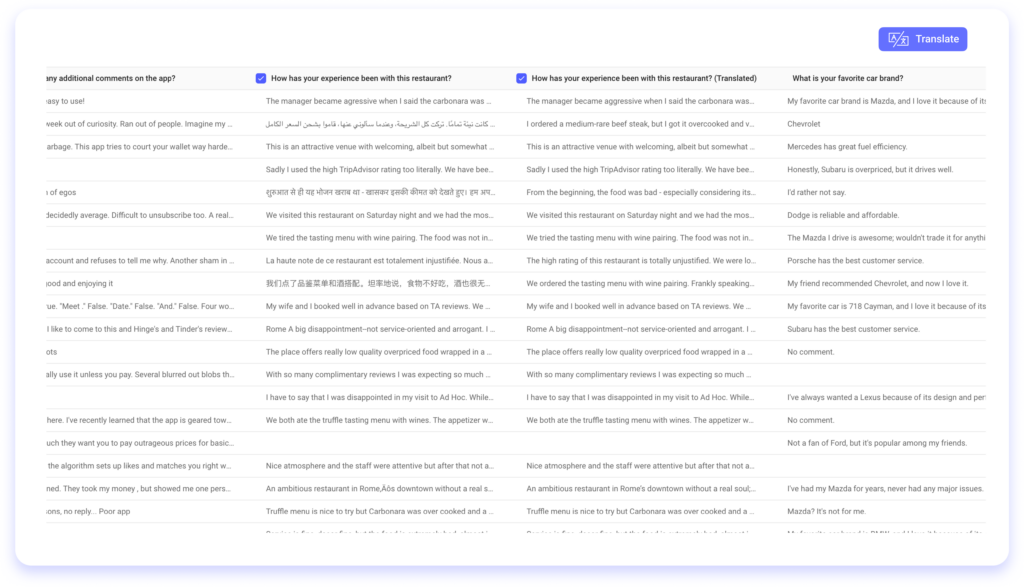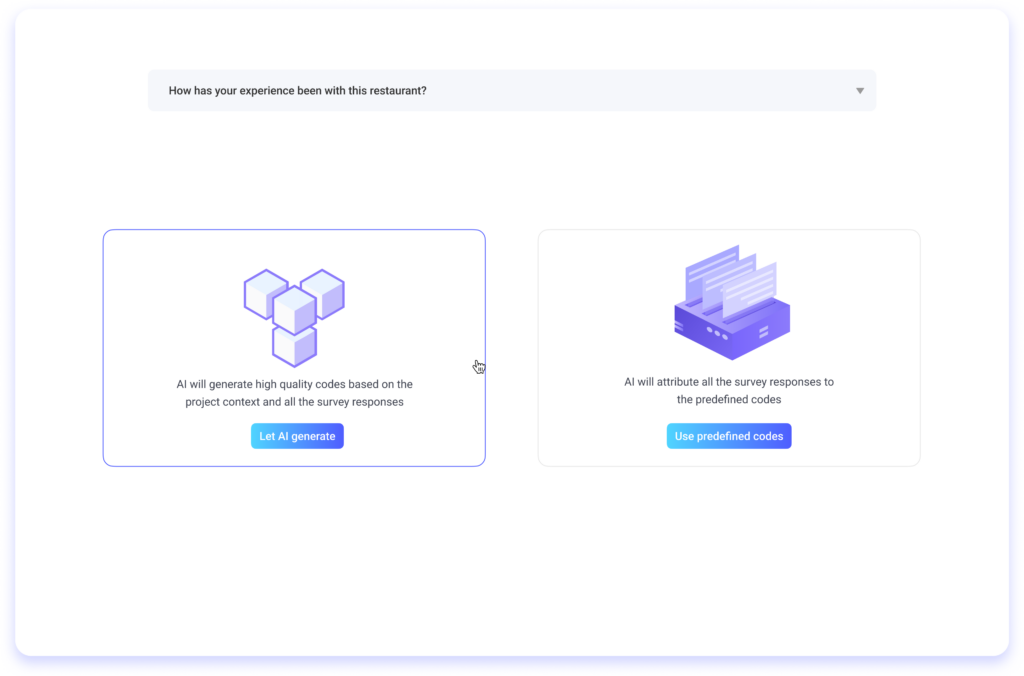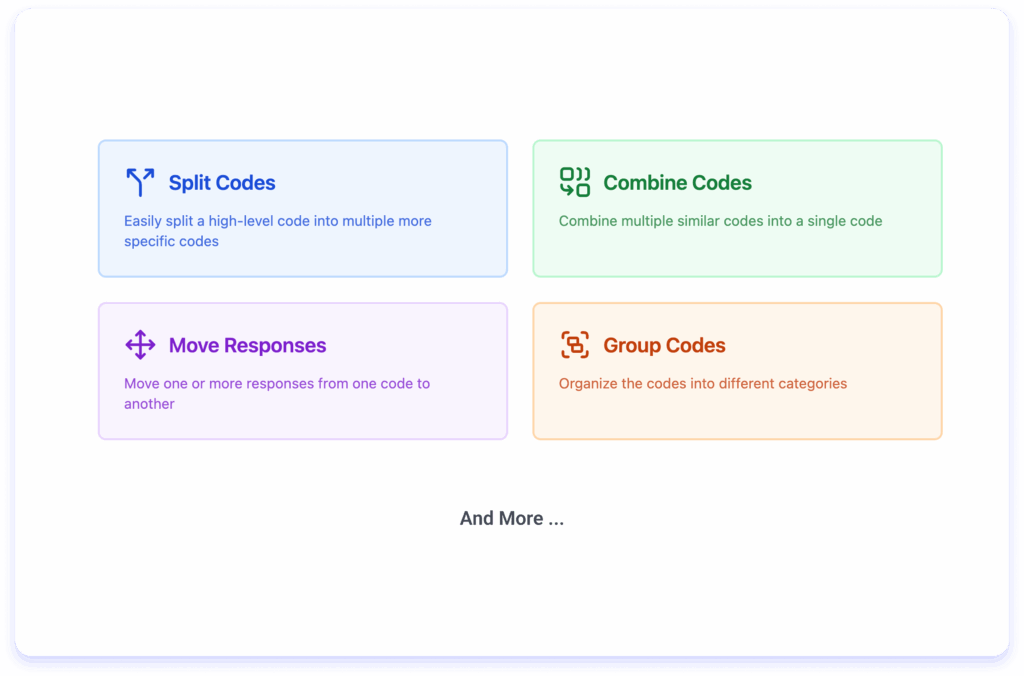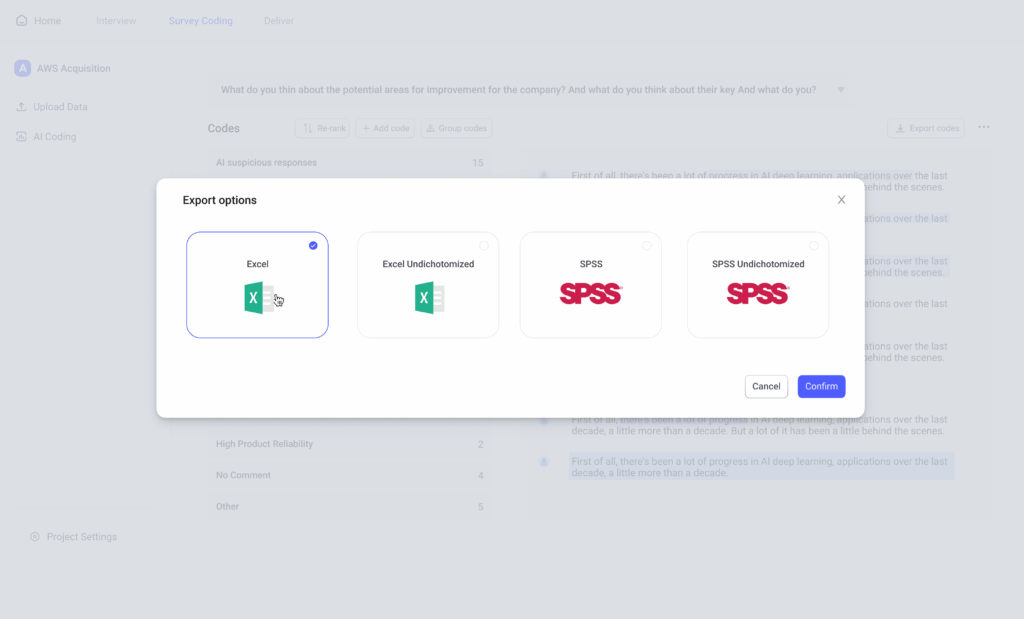In every survey, the most valuable insights often come from the open-ended questions, the ones where people can share their thoughts freely in their own words. These responses reveal why customers feel a certain way, what employees really think, or how consumers make decisions.
But they also create the biggest challenge: how do you analyze thousands of free-text answers quickly, accurately and consistently?
That’s where AI-powered survey analysis comes in. In this guide, we’ll explain how to analyze open-ended survey responses using AI, how it compares to manual coding, and what best practices can help you turn raw text into clear, actionable insights.
1. The Challenge of Open-Ended Survey Responses
Open-ended questions are designed to capture nuance, but that nuance can be very messy.
Manually reading and coding thousands of responses is slow, inconsistent and expensive. Typical challenges include:
- Time-consuming: Analysts may spend days categorizing responses for a few open-ended questions.
- Human bias: Different coders interpret responses differently, creating inconsistency.
- Scalability issues: Large datasets with multilingual responses can’t be handled efficiently by manual teams.
- Limited insight depth: With manual methods, it’s hard to see patterns across themes, sentiment or respondent types.
Traditional survey platforms often focus on quantitative data such as charts, averages and scores. But open-ended data holds the why behind the numbers.
2. How AI Transforms Open-Ended Survey Analysis
AI now makes it possible to analyze open-ended survey responses at scale with accuracy comparable to, and quite often exceeding, human coders, while maintaining consistency.
The latest AI technologies can:
- Categorize and code responses automatically into meaningful themes
- Summarize thousands of comments in plain language
- Detect sentiment (positive, negative, neutral)
- Visualize results as charts, clusters and word clouds
- Handle multiple languages and translate responses seamlessly
The result: what once took days can now be done in minutes without losing the human-level understanding of meaning and emotion.
AI survey open-ends analysis with exceptional accuracy
Let AI generate codes or use your own codebook
3. How to Analyze Open-Ended Survey Data with AI
Using BTInsights platform as an example
Step 1: Get Your Data Ready

Start with your survey dataset. Excel, CSV or SPSS all work fine. Once uploaded, below are some major actions you can perform to prepare your data for AI coding:
- Provide Context: Add a brief project description so the AI understands what the data represents.
- Handle Multilingual Data: If your dataset includes non-English responses, the AI can automatically detect and translate non-English responses into English.
- Easily Update Data: When new responses come in, simply add them. No need to re-upload the entire file. The system merges them cleanly and avoids duplicates.
- Transcribe Video Responses: If your survey includes video feedback, upload those too. The platform will transcribe hundreds of recordings in seconds, ready for coding alongside text data.
These steps ensure your dataset is clean, contextual and ready for AI analysis.
Step 2: Code the Open-Ended Responses

This is where the magic happens. You can either use your own code frame or let the AI generate one automatically.
If you’ve already built a code list (say, for brand perceptions or customer feedback), you can upload it from Excel or paste it right in. You can also reuse code frames from other projects to stay consistent.
You can also start fresh, the AI can do the heavy lifting. It reads through all the responses, finds common themes and generates a set of codes that make sense for your data.
It even handles special cases like:
- Entity coding (for questions like “What’s your favorite brand?”, it’ll pull out each unique mention), and
- Single-code attribution if you only want one “main” code per response.
In short, the AI does what a human analyst would, just a lot faster.
Step 3: Review, Edit and Fine-Tune

AI isn’t here to replace your judgment; it’s here to enhance and accelerate it.
Once the responses are coded, you can quickly review and refine them with a few clicks:
- Drag and drop responses from one code to another for reclassification.
- Split or merge codes to create more specific or broader themes.
- Add new codes easily. The AI will automatically reassign relevant responses.
- Group related codes under broader categories (or “nets”) either manually or with AI assistance.
- Label sentiment as positive, negative or neutral for deeper emotional insights.
Step 4: Export Your Results

We know it can be frustrating when everything looks perfect on-screen but the export format just doesn’t exactly align with your workflow. That often means extra hours spent reformatting just to integrate results properly.
To save your team that time, the BTInsights platform offers:
- Multiple export formats for different use cases and needs.
- Custom export templates that perfectly match your specific workflows.
Each export typically includes:
- Summary Tab: Displays all codes, counts and percentages.
- Details Tab: Lists original responses along with their assigned codes.
- Raw Data Tab: Converts qualitative coding into quantitative data (1s and 0s), which is ideal for charts, dashboards or cross-tabs.
4. Manual vs. AI-Assisted Survey Coding
| Criteria | Manual Coding | AI-Assisted Coding |
|---|---|---|
| Speed | Days or weeks | Minutes |
| Consistency | Varies by analyst | Consistent across datasets |
| Bias | Subject to human interpretation | Neutral and repeatable |
| Scalability | Limited to small samples | Handles thousands of responses |
| Cost | High labor cost | Fraction of the cost |
| Depth of Insight | Shallow summaries | Multi-dimensional (themes, sentiment, trends) |
AI doesn’t replace researchers; it amplifies them. Analysts can focus on interpretation, not repetitive tagging.
5. Best Practices for AI Survey Analysis
- Combine AI with Human Oversight: Let AI handle the heavy lifting, then refine categories for nuance.
- Use Clear, Contextual Prompts: If your tool allows customization, add project context (e.g., “These responses are about customer satisfaction with our new pricing model”).
- Regularly Review Your Themes: Update your categories as new trends emerge.
- Include Quant + Qual: Combine coded open-ends with quantitative metrics to tell a full story.
- Protect Data Privacy: Choose AI tools that meet compliance standards like SOC 2 or GDPR.
Final Thoughts
If your team is still manually coding open-ended survey responses, you’re missing a huge opportunity to leverage AI to automate the process. This lets your team focus on higher-value tasks and get more projects done.
BTInsights is the best AI survey analysis platform, trusted by market research teams at organizations such as The Washington Post to dramatically improve efficiency and analyze open-ended survey responses faster and with greater accuracy.
AI survey open-ends analysis with exceptional accuracy
Let AI generate codes or use your own codebook

